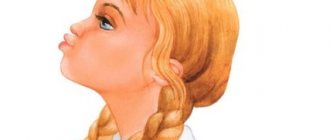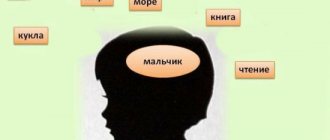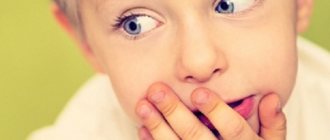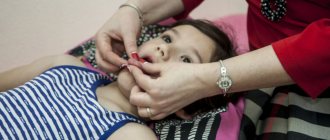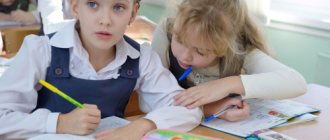Dysarthria is a violation of the pronunciation aspect of speech caused by insufficient innervation of the speech apparatus.
Speech dysarthria can be an independent speech defect, and can also be part of more complex speech disorders.
Violation of sound pronunciation cannot be considered a harmless defect, since it can entail serious negative consequences for the development of the child as a whole. Impaired sound pronunciation makes it difficult for schoolchildren to learn Russian. A child who pronounces sounds incorrectly is often imitated in the children's group, which creates additional psychological problems that can be avoided by teaching him the correct pronunciation in time.
Speech disorders significantly reduce compliance and quality of life. This means that the life of the parents does not improve either.
Signs of speech dysarthria
If the child cannot fully perform the movements necessary for speech.
How to check the mobility of a child’s speech organs?
- be able to open and close your mouth while “slapping” with your lips,
- be able to hold your mouth open for several seconds,
- open your mouth slightly, placing your wide tongue on your lower teeth and holding it there for several seconds,
- stick your tongue out of your mouth and put it back,
- be able to alternate between pulling your lips into a “tube” and a small smile (when performing this movement, your teeth should be closed and the movement is performed with your lips alone),
- do the “clock” exercise (alternately touch the corners of your mouth with your tongue),
- be able to raise the tongue on the upper lip and lower it on the lower lip several times,
- “lick” your upper lip,
- “puff out” your cheeks,
- make your cheeks “thin”,
- frown your eyebrows
- raise your eyebrows,
- blow on an imaginary candle.
What can parents be wary of?
- the child’s speech organs cannot maintain the same position for 5-6 seconds,
- if a child tries to keep his tongue motionless, the tongue turns blue from tension,
- if you notice increased salivation,
- inability to perform simple movements (pull your lips into a “tube” or “stick out and remove” your tongue,
- asymmetry in the work of the tongue muscles (when the tongue sticks out of the mouth, it deviates to the right or left),
- synchronous movements of the speech organs (performing one movement is accompanied by another; if a child raises his tongue, then his lower jaw rises behind his tongue; when the tongue moves left and right, the lower jaw makes similar movements),
- excessive range of motion (when touching the upper teeth, the tongue may stick out so that it touches the upper lip),
- difficult to switch from performing one movement to another,
- violation of muscle tone (muscles are either too relaxed, then the child’s face is mimic and the mouth is slightly open, or they are very tense, which makes it difficult to perform the necessary movements),
- twitching, trembling of individual muscle groups,
- strong nasalization of the voice, “nasal tone.”
With such disorders, the child cannot perform the movements necessary for full speech; he needs the help of a speech therapist who specializes in the correction of dysarthria and has the skills of speech therapy massage.
Dysarthric speech disorders in children of early and preschool age
Dysarthria (speech motor disorder) is a violation of the pronunciation aspect of speech caused by insufficient innervation of the speech muscles. Dysarthria is a consequence of organic damage to the central nervous system, in which the motor mechanism of speech is disrupted. With dysarthria, it is not the programming of speech utterance that is impaired, but the motor implementation of speech. The leading defects in dysarthria are disturbances in the sound-pronunciation aspect of speech and prosody, as well as disturbances in speech breathing, voice and articulatory motor skills.
Speech intelligibility in dysarthria is impaired, speech is blurred and unclear. Main disorders (structure of the defect) in dysarthria
Impaired tone of articulatory muscles (facial muscles, tongue, lips, soft palate) such as spasticity, hypotension or dystonia. 1. Spasticity - increased tone in the muscles of the tongue, lips, face and neck. With spasticity, the muscles are tense. The tongue is pulled back “lumpy”, its back is spastically curved, raised upward, the tip of the tongue is not pronounced. The tense back of the tongue raised towards the hard palate helps soften consonant sounds (palatalization). Sometimes the spastic tongue is pulled forward with a “sting.” An increase in muscle tone in the orbicularis oris muscle leads to spastic tension of the lips, tightly closing the mouth (voluntarily opening the mouth is difficult). In some cases, with a spastic condition of the upper lip, the mouth may, on the contrary, be slightly open. In this case, increased salivation (hypersalivation) is usually observed. Active movements with spasticity of the articulatory muscles are limited. (Muscle spasticity is noted with spastic-paretic dysarthria.) 2. Hypotonia - decreased muscle tone. With hypotonia, the tongue is thin, spread out in the oral cavity; lips are flaccid and cannot close tightly. Because of this, the mouth is usually half-open, and hypersalivation may be expressed. Hypotonia of the muscles of the soft palate prevents the velum from moving sufficiently upward and pressing it against the back wall of the pharynx; a stream of air exits through the nose. In this case, the voice acquires a nasal tint (nasalization). (Hypotonia of articulatory muscles occurs with spastic-paretic and ataxic dysarthria.) 3. Dystonia is a changing nature of muscle tone. At rest, low muscle tone may be noted; when attempting to speak and at the moment of speech, the tone increases sharply. Dystonia significantly distorts articulation. A characteristic feature of sound pronunciation in dystonia is the inconstancy of distortions, substitutions and omissions of sounds. (Dystonia is noted with hyperkinetic dysarthria.)
In children with neurological pathology, a mixed and variable nature of tone disturbances in the articulatory muscles (as well as in the skeletal muscles) is often noted, i.e. in individual articulatory muscles, tone can change differently. For example, spasticity may be observed in the lingual muscles, and hypotonia in the facial and labial muscles. In all cases, there is a certain correspondence between tone disturbances in the articulatory and skeletal muscles. Impaired mobility of articulatory muscles. Limited mobility of the muscles of the articulatory apparatus is the main manifestation of paresis of these muscles.
Insufficient mobility of the articulatory muscles of the tongue and lips causes disturbances in sound pronunciation. When the lip muscles are damaged, the pronunciation of both vowels and consonants suffers. Articulation in general is impaired. Sound pronunciation is especially severely impaired when the mobility of the tongue muscles is sharply limited. The degree of impairment of the mobility of articulatory muscles can be different - from complete impossibility to a slight decrease in the volume and amplitude of articulatory movements of the tongue and lips. In this case, the most subtle and differentiated movements are disrupted first (primarily raising the tongue upward).
Specific violations of sound pronunciation : - persistent nature of violations of sound pronunciation, particular difficulty in overcoming them; - specific difficulties in automating sounds (the automation process requires more time than with dyslalia). If speech therapy classes are not completed on time, acquired speech skills often disintegrate; - the pronunciation of not only consonants, but also vowels is impaired (average or reduced vowels); - the predominance of interdental and lateral pronunciation of whistling [s], [z], [ts] and hissing [sh], [zh], [h], [sch] sounds; - deafening of voiced consonants (voiced sounds are pronounced with insufficient participation of the voice; - softening of hard consonant sounds (palatalization); - disturbances in sound pronunciation are especially pronounced in the speech stream. With an increase in speech load, general blurriness of speech is observed and sometimes increases.
Depending on the type of violation, all sound pronunciation defects in dysarthria are divided into two categories: anthropophonic (sound distortions) and phonological (substitutions, confusions). In dysarthric disorder, the most typical violation of the sound structure of speech is sound distortion.
Speech breathing disorders . Breathing disorders in children with dysarthria are caused by insufficient central regulation of breathing. Insufficient depth of breathing. The rhythm of breathing is disturbed: at the moment of speech it becomes more frequent. There is a violation of the coordination of inhalation and exhalation (shallow inhalation and shortened weak exhalation). Exhalation often occurs through the nose, despite the half-open mouth. Respiratory disorders are especially pronounced in the hyperkinetic form of dysarthria.
Voice disorders . Voice disorders are caused by changes in muscle tone and limited mobility of the muscles of the larynx, soft palate, vocal folds, tongue and lips. The most common symptoms are insufficient voice strength (quiet, weak, fading) and deviations in voice timbre (dull, nasal, constricted, hoarse, intermittent, tense, guttural).
In various forms of dysarthria, voice disturbances are of a specific nature. Violations of prosody (melodic-intonation and tempo-rhythmic characteristics of speech). Melody-intonation disorders are often considered one of the most persistent signs of dysarthria. They greatly influence the intelligibility and emotional expressiveness of speech. There is a weak expression or absence of vocal modulations (the child cannot voluntarily change the pitch). The voice becomes monotonous, poorly or unmodulated.
Violations of speech tempo are manifested in its slowing down, less often - in acceleration. Sometimes there are disturbances in the rhythm of speech (for example, chant - “chopped” speech, when there is an additional number of stresses in words).
Lack of kinesthetic sensations in the articulatory apparatus. In children with dysarthria, there is not only a limitation in the range of articulatory movements, but also a weakness in the kinesthetic sensations of articulatory postures and movements.
Autonomic disorders. One of the most common autonomic disorders in dysarthria is hypersalivation. Increased salivation is associated with limited movements of the tongue muscles, impaired voluntary swallowing, and paresis of the labial muscles. It is often aggravated due to the weakness of kinesthetic sensations in the articulatory apparatus (the child does not feel the flow of saliva) and decreased self-control.
Hypersalivation can be expressed to varying degrees. It can be constant or intensify under certain conditions. Even mild hypersalivation (moistening of the corners of the lips during speech, slight leakage of saliva) indicates the presence of neurological symptoms in the child. Less common are vegetative disorders such as redness or pallor of the skin, increased sweating during speech.
Violation of the act of receiving food. Children with dysarthria often have difficulty, and in severe cases, no chewing of solid food or biting off a piece. Choking and choking when swallowing are often observed. Difficulty drinking from a cup. Sometimes coordination between breathing and swallowing is impaired.
The presence of synkinesis. Synkinesias are involuntary accompanying movements when performing voluntary articulatory movements (for example, additional upward movement of the lower jaw and lower lip when trying to raise the tip of the tongue). Oral synkinesis - opening of the mouth during any voluntary movement or when attempting to perform it. Increased pharyngeal (gag) reflex. Loss of coordination of movements (ataxia).
Ataxia manifests itself in dysmetric, asynergic disorders and in the scantiness of the rhythm of speech. Dysmetria is a disproportion, inaccuracy of voluntary articulatory movements. It is most often expressed in the form of hypermetry, when the desired movement is realized in a more sweeping, exaggerated, slower movement than necessary (excessive increase in motor amplitude). Sometimes there is a lack of coordination between breathing, voice production and articulation (asynergia). Ataxia is noted with ataxic dysarthria.
The presence of violent movements (hyperkinesis and tremor) in the articulatory muscles. Hyperkinesis - involuntary, irregular, violent; There may be pretentious movements of the muscles of the tongue and face (hyperkinetic dysarthria). Tremor - trembling of the tip of the tongue (most pronounced during targeted movements). Tremor of the tongue is observed with ataxic dysarthria.
From the book Prikhodko O. G. “Speech therapy massage for the correction of dysarthric speech disorders in children of early and preschool age.
Correction of dysarthria
A comprehensive program for the correction of dysarthria is carried out by interdisciplinary interaction of specialists from the Miracle Doctor clinic:
- Speech therapist Correction of speech disorders in individual lessons. The specialist conducts speech therapy massage using special probes (Novikova probes); carries out sound pronunciation correction.
- Neurologist The doctor prescribes medication and conducts repeated examinations to correct the treatment.
When a child is admitted to the children's speech therapy department, an in-depth initial examination by a speech therapist is carried out. The frequency of visits and duration of the course depends on the age of the child, the degree of speech impairment and is determined by specialists.
Severity of dysarthria
Dysarthria in a child has 3 degrees of severity:
- Anarthria is the complete absence of voice and speech. Some inarticulate sounds are possible.
- Direct dysarthria. The child is able to use oral speech, but it is inarticulate, incomprehensible to others, there are gross violations of sound pronunciation, and breathing, voice and intonation expressiveness are also significantly impaired.
- Erased dysarthria. This type of disease occurs most often. The child does not stand out much among his peers, but at the same time he is quite awkward, quickly gets tired in the process of performing loads, and has persistent disorders in the pronunciation of sounds (mostly hissing and whistling). When speaking, the child’s problems with articulation are not clearly expressed, the lips move minimally.
Massage for dysarthria
The mechanism of action of massage is complex. It consists not only of a direct mechanical effect on the tissue being massaged, but also of a neuroreflex and humoral effect. In speech therapy work for dysarthria, it is necessary to skillfully use massage techniques, both relaxing tense spastic muscle groups and leading to irritation and toning of the neuromuscular speech apparatus.
To best obtain the relaxation effect, you need to create a calm environment: the room should be warm, the child should not be distracted by anything, he should sit or lie comfortably, without tension and not focus his attention on the organs of the speech apparatus - all this can be achieved with the help of autogenic training and some other psychotherapeutic techniques. You can turn on soothing music or an educational cartoon.
The massage should be carried out with warm, dry hands wearing gloves, using light strokes necessary for a specific muscle group. With a tonic massage, on the contrary, more intense and sharp movements of kneading, patting, and tapping are recommended. Massage of the affected muscle group should be preceded by an impact on the entire neck-brachial area to enhance blood and lymph circulation. When using probe massage, instruments must be thoroughly washed and sterilized in a special solution.
To achieve the best result of correctional work, it is advisable to combine massage with exercises of passive and active articulatory gymnastics, which allow you to teach the child to relax all spastic muscles, achieve the full amplitude of voluntary movements, hold the lips and tongue in a certain position, inhibit synkinesis, achieve precision in articulatory postures and switch easily from one articulatory pose to another.
As a rule, sets of exercises are selected individually, taking into account the clinical manifestations of dysarthria, the degree of its severity, the child’s age, his personality, intelligence, etc. In all cases, breathing exercises are included in the set of exercises for speech therapy correction, since breathing is the energetic basis of speech and in case of weak Speech breathing makes it difficult to form both the voice and speech noises.
How to Diagnose and Treat the Disorder
Diagnosis of the disorder is the prerogative of neurology and speech therapy. Instrumental research methods play a special role in making a diagnosis: EEG, electroneurography, electromyography, MRI, transcranial magnetic stimulation.
The speech therapist, in turn, must examine the condition of the speech-motor organs, facial and facial muscles. The specialist evaluates the nature of speech: how understandable it is for perception, the correct pronunciation of individual sounds, its tempo, rhythm, intonation, volume, synchronicity of the articulatory apparatus, and grammatical aspects.
Written speech is assessed by asking the patient to copy some text or take dictation.
Treatment of the disorder should begin with relief of the underlying disease. But speech disorders cannot be ignored.
It is advisable to begin correction of dysarthria as quickly as possible. Feeling his own conversational peculiarities, the patient will try to limit communication in society. This will lead to worsening of the speech defect. For example, from the first stage it will develop into the second. Isolation can also make it difficult to understand normal speech.
Therefore, in addition to treating the underlying disease, correction of speech defects is carried out. For this purpose, physiotherapy methods are used:
- various types of massage, including Shiatsu - influencing reflexogenic points using the finger method;
- acupuncture;
- physical therapy, including the use of special simulators;
- medicinal baths.
It is permissible for a psychoneurologist to prescribe psychotropic drugs as aids to normalize the psycho-emotional background.
Speech therapy treatment consists of using:
- speech therapy massage – working out the facial muscles. It allows you to improve blood circulation and restore normal muscle tone. Used to improve speech motor skills;
- exercises for voice production - the work of the vocal cords, volume and timbre of the voice are regulated;
- finger gymnastics – development of fine motor skills of the hands, which is interconnected with speech function;
- learning to position the organs of articulation for correct pronunciation;
- prosodic exercises - work on intonation, strength, height, tempo of the voice. Helps eliminate monotony;
- breathing exercises. Her exercises establish the correct breathing rhythm during speech activity.
Among the psychotherapeutic techniques used:
- art therapy;
- laughter therapy;
- clay and wax therapy;
- aromatherapy;
- music therapy;
- chromotherapy or color therapy.
The integrated use of all treatment methods makes it possible to correct speech disorders. In some cases, dysarthria can be completely eradicated, in others, lasting positive changes can be achieved.
It is also important to teach patients how to live in society with their problem. People with dysarthria are taught to establish eye contact with the interlocutor, use nonverbal methods of expression - gestures, pictures, etc., and the ability to recognize that the interlocutor has understood him.
Correction of the pronunciation aspect of speech
The pronunciation side of speech includes sound pronunciation and prosody (intonation, melody, pause, stress, tempo, rhythm and timbre). The functioning of the pronunciation side of speech is closely related to articulatory motor skills and the phonemic side of speech. Pronunciation of sounds is the phonetic design of speech and at the same time a complex of speech motor skills by which it is determined.
Corrective work is based on the following principles:
- Connections of speech with other aspects of mental development. To implement it, correctional influence is carried out not only on speech activity, but also on non-speech processes, the patient’s personality as a whole;
- Systematic approach. The pronunciation side is considered as a system that includes a number of components. Corrective work is aimed at their development (development of articulatory motor skills, sound pronunciation, phonemic perception, prosody);
- The development principle involves analyzing the process of the occurrence of a defect. The immediate result of impaired sound pronunciation in patients with dysarthria is limited mobility of the speech organs. Difficulties in articulation cause pronunciation deficiencies, which can be expressed to varying degrees. One manifestation may be a consequence or cause of another. Corrective work is directed not only at the consequence of the violation - defects in sound pronunciation, but also at their root cause - violations of articulatory motor skills.
Correctional speech therapy work is carried out using various methods: practical, visual, verbal. Practical methods include imitative-performing, constructive and creative exercises, games and modeling. Visually - observation, examination of profiles, diagrams, showing a sample task and method of action. The main verbal methods are conversation, reading, story.
Correction stages
The first stage of correction of erased dysarthria is preparatory. Work to overcome speech disorders begins with overcoming the layers and secondary phenomena that interfere with correct pronunciation:
- Excessive drooling;
- Muscle passivity;
- Deficiencies in phonemic awareness and perception;
- Preparing muscles for the formation of articulatory patterns.
At the second stage, the speech therapist’s work is aimed at overcoming the main disorder – phonetic speech deficiencies. It lies in the production of sounds. The third stage is the inclusion of the patient in active communication.
Natural exercise of the muscles of the oral region is the act of eating. Training the masticatory muscles using a natural process is given attention from an early age. A patient who has suffered a stroke or traumatic brain injury, suffering from degenerative diseases of the nervous system or cerebral palsy, is taught chewing techniques, especially chewing with the mouth closed, and is taught to alternately chew on the right and left sides of the mouth.
If older children exhibit early reflexes (sucking), work is carried out aimed at inhibiting delayed reflexes. Speech therapists use a mechanical obstacle to prevent unnecessary movement. The speech therapist fixes the muscles of the mouth with his hands, and fixes involuntary movements of the tongue with a spatula or biting the tongue with his teeth. To remove friendly movements, the chin is fixed with the hand of a speech therapist. The reflex of the relationship between the movements of the mouth and hand can be inhibited during articulation gymnastics by fixing the child’s hands with the hand of a speech therapist.
At the same time, they develop the ability to voluntarily control their muscles. The patient is given a goal, encouraged to control movements, uses visual control, and encourages the slightest success. It is difficult to slow down reflexes in the oral area, as this area is vital and sensitive. Not only the muscular system is highly developed in it, but also all types of sensitivity: tactile, taste, temperature.
To overcome drooling, the patient is taught to swallow saliva. For this purpose, massage the masticatory muscles, induce swallowing movements, tilt the head back and offer to swallow saliva. To stimulate chewing movements, you can give the patient a cookie or roll and teach him to chew in front of a mirror, alternating chewing with swallowing.
The patient is taught to voluntarily close his mouth through passive movements of the lower jaw, which are initially performed by a speech therapist. He places his hand under the lower jaw, under the chin, puts the other on the patient’s head and closes the jaws with light pressure. Then the patient is taught to perform this movement independently on command: open your mouth, close your mouth.
The patient is taught techniques of voluntary relaxation - relaxation. The training begins with general relaxation. They are taught to voluntarily relax the muscles of the upper and lower extremities, then the neck and head. Develop the ability to distinguish between tension and relaxation and regulate according to instructions. Exercises are carried out in a playful way.
To relax, stroking, vibration and other relaxing massage techniques are used. Acupressure is used for the same purpose. This work is carried out by massage therapists at the Yusupov Hospital after consultation with a neurologist and rehabilitation specialist.
Forms of dysarthria in children
Depending on the location of the brain lesion, dysarthria in a child can have the following forms:
- Bulbar—the nuclei of the peripheral motor nerves located in the brain stem are affected;
- Pseudobulbar - caused by damage to the conduction systems that ensure the conduction of nerve impulses from the cerebral cortex to the nuclei of the medulla oblongata;
- Subcortical dysarthria is associated with damage to the subcortical nuclei, which are responsible for the regulation of muscle tone and emotional expressiveness of speech;
- Cortical—the cortical structures of the brain, which are responsible for the most subtle innervation of the speech muscles and the formation of speech praxis, are affected;
- Cerebellar - the nuclei and pathways of the cerebellum, which are responsible for coordination in the work of the respiratory, vocal, articulatory apparatus and for the emotional expressiveness of speech, are affected. Rarely found isolated from other species.
